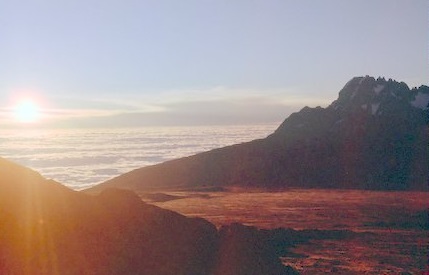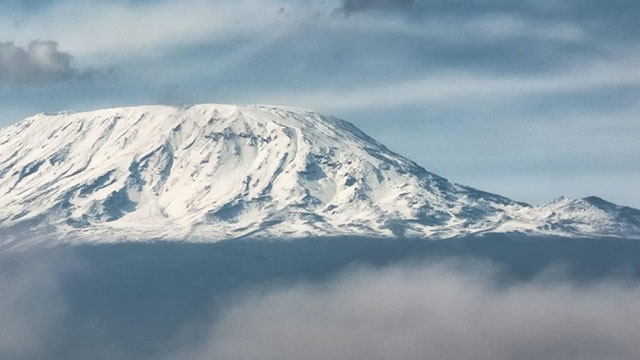
With many thanks to Norval Reece of Newtown Monthly Meeting who wrote the following piece about his experience climbing Mt. Kilimanjaro following a Quaker assignment in India. Norval was at the Friends Centre in Delhi, sponsored by the AFSC and British Friends Service Council. He is a member of Newtown Meeting and previously published a version of this story in the Courier Times of Bucks County (PA).
We climb some mountains for the thrill of reaching the summit. We climb others in order to survive.
During the pandemic we have all climbed mountains of isolation, despair, boredom, fear, and economic uncertainty. I was recently reminded of climbing another mountain — Mt. Kilimanjaro. In retrospect it seems like (a) prologue for surviving Covid 19.
Mt. Kilimanjaro is the highest mountain in Africa and the highest single free-standing mountain in the world at 19,341 feet.
My reminder was an email from my fellow climber now living in Australia. Attached was an old Mt. Kilimanjaro trail map with its recommendations for a climber to hire a guide and four porters, allow 8-10 days for proper acclimatization to the extreme altitude, and avoid “the long rains in April and May.”
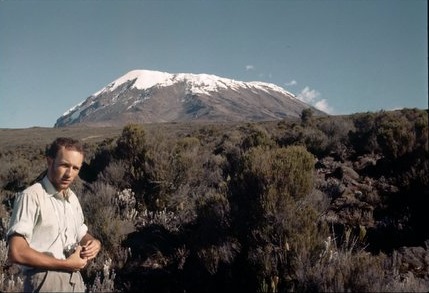
In 1962, the two of us climbed Mt. Kilimanjaro in five days, in the rain, with no guide and no porters. I arrived in Marangu, Tanganyika May 7, while hitchhiking home from India after two years of service with the Quakers. The next morning, I picked up a trail map, a walking stick, hired a guide, strapped on my backpack, and started out. We climbed in the rain for ten miles through the bushland into the rainforest, reaching Bismark Hut at 9,000 feet in late afternoon.
There we met a young photographer from Southern Rhodesia and his guide. Neil Fletcher was in his twenties like me and soon we somewhat impulsively decided to release our guides and climb together.
We started early the next morning for Peter’s Hut at 12,335 feet. The rainforest averaged 7-8 feet of rain a year and we arrived late afternoon very tired and very wet.
The next day we awakened early and continued climbing. The trail soon became rocky with no vegetation and the high altitude forced us to rest frequently. We cheered up when we reached the “Alpine Desert” plateau and saw the snow-capped crest of Kilimanjaro jutting through the clouds.
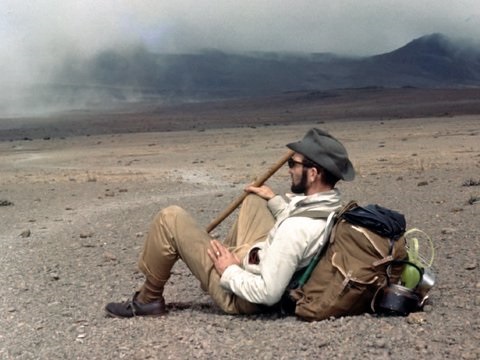
At dusk we arrived at the tin roofed Kibo Hut at 15,520 feet and conked out immediately. We planned to leave at 3 a.m. to allow time to get to the summit and back before dark. When we awakened we were startled to find it was 8 a.m. Hurriedly we stuffed hard candies into our pockets, put on all the clothes we had for the bitter cold, grabbed our walking sticks, and headed out.
There was no trail in the loose scree and the altitude was debilitating as we zig-zagged our way up the steep slope. Five steps. Rest. Five steps. Rest. The scree now became snow. The oxygen intake at this altitude is half what it is at sea level. I had been struck down once before by height sickness while climbing in the Himalayas and I knew it was a serious risk.
Hours later, exhausted, we reached Gilman’s Point on the crater rim at 18,635 feet and were rewarded by the spectacular view inside the old volcano! Spires of ice rose brilliantly from the caldera floor 1,000 feet below. It was mid-afternoon as we slowly crept around the narrow rim for a mile and a quarter to reach Uhuru, the highest point.
At 5:05 p.m. we finally stood on the 19,341 foot peak and signed our names, date, and time in the famous book in the wooden box! The setting sun was sensational. But we knew the sudden darkness would greatly reduce our chances of getting safely back to the hut.
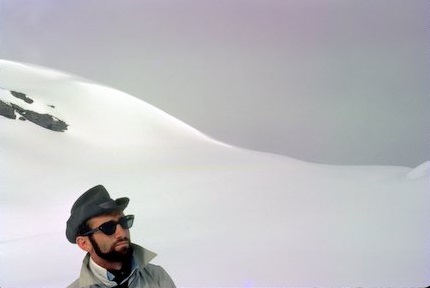
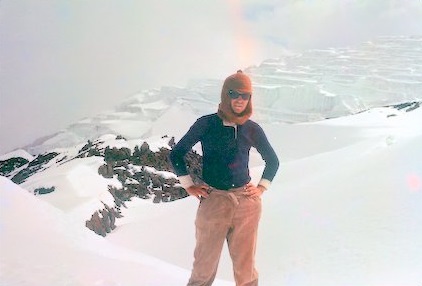
We slipped and slid as we hurried down through the snow and scree in the dark and finally reached Kibo Hut around 7:30 p.m. We found a British army training unit at the hut whose leader lectured us about being on the mountain after dark and said “and you don’t even have food or water.” We told him we brought down snow in our rucksacks to melt for tea which he remarked to his unit “as being very clever.” But they didn’t offer us any food or even tea. We melted the snow we had carried down in our slickers, made a supper of tea and candy, and collapsed.
Two of the five came banging on the door at 7 a.m. the next morning after failing to make the summit “because it was too hard and too cold” — even with all their climbing gear. I told them they were bloody lucky to have the Yanks to bail them out of world wars if two hitchhikers with no equipment could accomplish what the British Army could not. We laughed all the way down the mountain — tired and hungry though we were.
The next morning, out of food, we decided to try to get down the mountain in one day — 32 miles and 15,000 feet below. Ten hours later, wet and tired with sore feet, we reached Bismark Hut at 9,000 feet and found the tins of bully beef (corned beef) we had left four days earlier. I remember it as one of my best meals ever.
It was now 5:30 p.m. with ten miles to go to reach the Inn by the strict 8:00 p.m. dinner deadline. We didn’t make it, but the British proprietress, bless her heart, loaned us some clean clothes, told us to shower, and gave us a spectacular meal.
The struggle up and down that mountain reminds me of what we have been going through during the long pandemic – one very tough slog.
The journey of a thousand miles begins with a single step. But it takes thousands of steps to reach the end.
By doggedly placing one foot in front of the other and concentrating only on the next ‘step’ a couple of hitchhikers climbed Mt. Kilimanjaro. Just as we have all doggedly climbed our pandemic mountains.
One tough slog. But we’re getting there. One step at a time.
Featured Image source: Photo by Sergey Pesterev on Unsplash
Other images courtesy of Norval Reece
